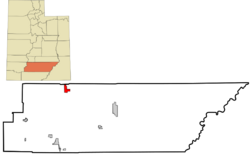Antimony, Utah facts for kids
Quick facts for kids
Antimony, Utah
|
|
|---|---|
|
Town
|
|

Location in Garfield County and in the state of Utah.
|
|
| Country | United States |
| State | Utah |
| County | Garfield |
| Settled | 1878 |
| Incorporated | 1934 |
| Named for | Antimony |
| Area | |
| • Total | 9.82 sq mi (25.44 km2) |
| • Land | 9.82 sq mi (25.44 km2) |
| • Water | 0.00 sq mi (0.00 km2) |
| Elevation | 6,453 ft (1,967 m) |
| Population
(2020)
|
|
| • Total | 118 |
| • Estimate
(2019)
|
121 |
| • Density | 12.32/sq mi (4.76/km2) |
| Time zone | UTC-7 (MST) |
| • Summer (DST) | UTC-6 (MDT) |
| ZIP code |
84712
|
| Area code(s) | 435 |
| FIPS code | 49-01860 |
| GNIS feature ID | 1438250 |
Antimony is a small town located in Garfield County, Utah, United States. It's a quiet place with a rich history. In 2020, about 118 people lived there.
Contents
Where is Antimony Located?
Antimony is found in the beautiful state of Utah. It covers an area of about 10.1 square miles (25.44 square kilometers). All of this area is land, with no large bodies of water.
Trails and Nature
If you love the outdoors, you might be interested to know that the famous American Discovery Trail passes right through Antimony. This trail is a huge network of paths that crosses the entire United States!
Antimony's Weather
The weather in Antimony changes a lot with the seasons. Summers are usually warm or hot, and sometimes humid. Winters can be very cold. This type of weather is known as a humid continental climate.
Antimony's History
The story of Antimony began in 1873. A group of 22 men came to this area. Their goal was to make peace with the local Fish Lake band of Native Americans.
How Antimony Got Its Name
While exploring, these men found some coyote pups. Because of this, they first named the area Coyote. The first people to settle here permanently arrived in 1878.
Then, in 1880, something important was discovered. Miners found deposits of a special rock called stibnite in Coyote Canyon. This rock contains a metal called antimony. Mining for this metal became a big industry. Because of the mining, the town changed its name from Coyote to Antimony in 1921.
Fun Facts About Antimony
Antimony is known for its unique way of celebrating the Fourth of July. They have a fireworks show that's a bit different from what you might expect! It includes bottle rockets and free sparklers for kids over three years old.
The town used to hold the fireworks in the park. But under Mayor Shannon Allen, they moved the display. Now, the fireworks light up the sky over Otter Creek Reservoir.
Who Lives in Antimony?
| Historical population | |||
|---|---|---|---|
| Census | Pop. | %± | |
| 1940 | 245 | — | |
| 1950 | 187 | −23.7% | |
| 1960 | 161 | −13.9% | |
| 1970 | 113 | −29.8% | |
| 1980 | 94 | −16.8% | |
| 1990 | 83 | −11.7% | |
| 2000 | 122 | 47.0% | |
| 2010 | 122 | 0.0% | |
| 2019 (est.) | 121 | −0.8% | |
| U.S. Decennial Census | |||
In 2010, there were 122 people living in Antimony. These people lived in 40 different homes. Most of the people were White, and a small number were Native American or from two or more backgrounds.
Many homes in Antimony had children under 18 living there. The average age of people in Antimony was 37 years old. This means there's a mix of younger and older residents.
See also
 In Spanish: Antimony para niños
In Spanish: Antimony para niños

